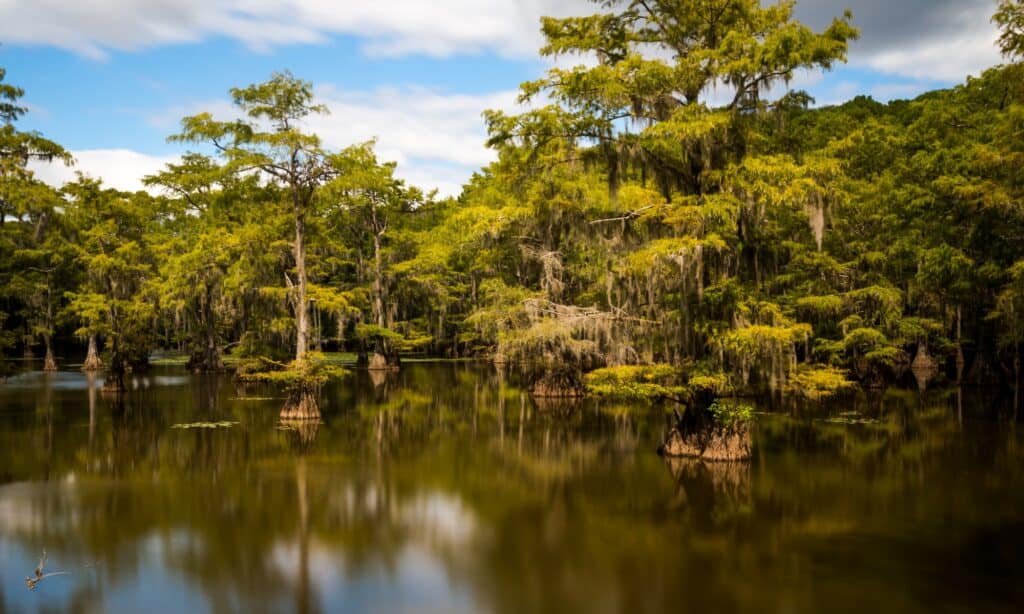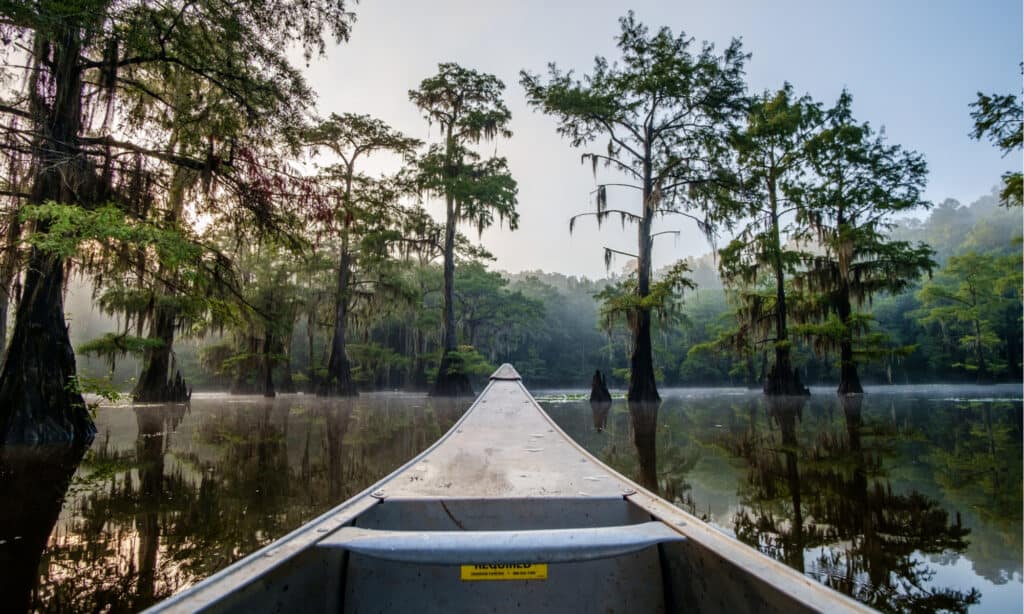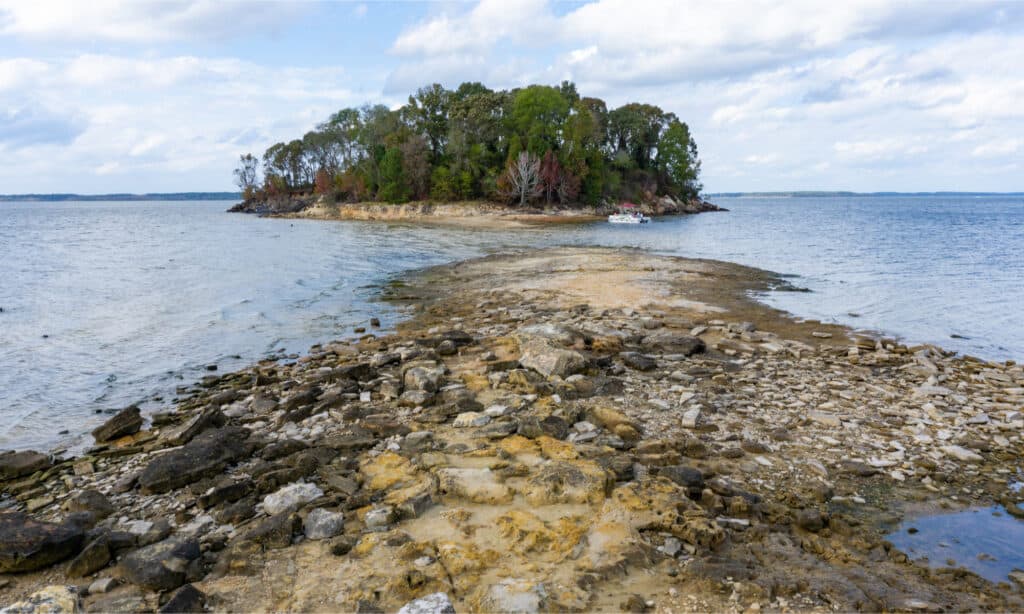If you’re from Texas, you may have heard that the state only has one natural lake. And while there may be more artificial lakes than naturally occurring ones, there are many, if not thousands, of small intrinsic bodies of water. Natural lakes are defined by depressions in the ground that fill when it rains or other causes of nature outside of man’s influence. Find out how many natural lakes are in Texas and discover some of the biggest artificial lakes.
How Many Natural Lakes Are in Texas?

Most of the natural lakes in Texas are horseshoe bends, called resacas.
©Victoria Ditkovsky/Shutterstock.com
There are over 7 thousand natural lakes in Texas. Due to varying factors, the exact number is unknown. Many of the naturally-occurring lakes in Texas are horseshoe bends, called resacas, formed from a main river channel. You will find many resacas in East Texas, and in the Southern Plains, you have playas or desert basins that fill with water during rainy seasons. Here are the most popular natural lakes in Texas.
Green Lake
Located on the Guadalupe River flood basin is Green Lake, a natural tidal lake in Calhoun County. Initially, it was a northern inlet of San Antonio Bay, and as the Guadalupe River shifted west 2,500 years ago, it formed a delta that advanced into the bay. The delta completely extended across the bay around 2,200 years ago, creating present-day Green Lake.
Researchers uncovered pottery and burial grounds belonging to the Karankawa indigenous people in the area. They would have used the lake and surrounding forest for fishing and hunting. Green Lake is 13 miles in circumference and about two miles wide, with an average depth of four feet. It is the largest natural freshwater lake entirely in Texas and covers an area of 10,000 acres.
Sabine Lake
Sabine Lake is one of several estuaries along the Gulf Coast of Texas. This lake is formed by the Neches and Sabine Rivers’ confluence and connects to the Gulf of Mexico through Sabine Pass. This bay covers the Gulf Coast of Texas and Louisiana, forming part of the Texas-Louisiana border.
Several Native American groups inhabited the lake’s shore as far back as 500 CE, and English explorers mapped the lake in 1777. In the present day, Sabine Lake is a center for shipping and petrochemical industries.
Caddo Lake

Caddo Lake is naturally occurring and one of the country’s most extensive flooded cypress forests.
©Daniel Mullins/Shutterstock.com
This lake lies on the Texas and Louisana border in Harrison County, Marion County in Texas, and Caddo Parish in Louisiana. The lake is 25,400 acres and is both a lake and wetland (bayou) and one of the country’s most extensive flooded Cypress Forests. It is one of the few non-oxbow lakes in the state, and there are a few theories about how it formed. Researchers believe it was either created by catastrophic earthquakes in the early 1800s or by a 100-mile log jam on the Red River in Louisiana which could have flooded the low-lying basin.
However, humans added dams in the 1900s, artificially altering the lake. Native Americans utilized the area for thousands of years until industry found a use for it in the 19th century. They discovered oil at the bottom of the lake in the 1900s and began erecting oil rigs, damaging the fragile ecosystem. It is now an internationally protected wetland.
Other Natural Lakes in Texas
Natural Dam Lake is 28,000 acres seven miles west of Big Spring and is regulated by the Texas Water Commission. This state mainly uses the lake for flood control, and it is usually dry. It is also on private property owned and managed by the Wilkinson Ranch.
Big Lake is another natural lake located in a rural city by the same name. It is a playa (dry lake) and only fills with water after high-runoff rainfall and is significant in size during wet periods. During dry spells, local ranchers use the lake for grazing.
Artificial Lakes in Texas

Most of the lakes in Texas are artificial and created by damming rivers and streams.
©Bonnie Taylor Barry/Shutterstock.com
Artificial lakes are typically reservoirs, and people create them by damming rivers or streams and flooding the surrounding floodplain. Artificial lakes are beneficial as they store water for agricultural purposes and always ensure a fresh water supply. They also create essential habitats for wildlife. Check out the largest artificial lakes in Texas.
Toledo Bend Reservoir
This reservoir is the largest artificial lake in the South. Toledo Bend is a reservoir on the Sabine River, straddling Texas and Louisiana with an area of 181,600 acres. The dam is in Northwest Newton County, Texas, and produces 92 megawatts of hydroelectric power. This lake has 1,200 miles of shoreline and is a significant resource for outdoor recreation like swimming, boating, and fishing.
Lake Livingston
Lake Livingston is in the coniferous forest of East Texas. It is a reservoir constructed by the Trinity River Authority in the 1960s and is the second largest lake entirely within Texas boundaries. You will find this lake and recreational area about seven miles southwest of Livingston, where you will find full-service marinas and camping spots along the shoreline.
Sam Rayburn Reservoir

Sam Rayburn Reservoir is the largest lake entirely within the Texas border.
©Jordan Pitre/Shutterstock.com
You will find the Sam Rayburn Reservoir 70 miles north of Beaumont in East Texas. This lake is a significant tributary of the Neches River. It is the largest lake within the Texas border, with an almost four million acre-feet capacity. Construction of the reservoir began in 1956 with the purpose of flood control, water conservation, and hydroelectric power. Sam Rayburn is open to the public, and people use its water for fishing and boating.
Lake Texoma
Lake Texoma borders Bryan County, Oklahoma, and Grayson County, Texas, and it is one of the largest reservoirs in the United States. However, a considerable amount of the lake is in Oklahoma. Construction of the lake began during World War II, and German POWs were involved in the dam construction. Today, the lake is one of the most popular recreational areas in Oklahoma, bringing over 6 million visitors yearly.
The photo featured at the top of this post is © Daniel Mullins/Shutterstock.com
Thank you for reading! Have some feedback for us? Contact the AZ Animals editorial team.






